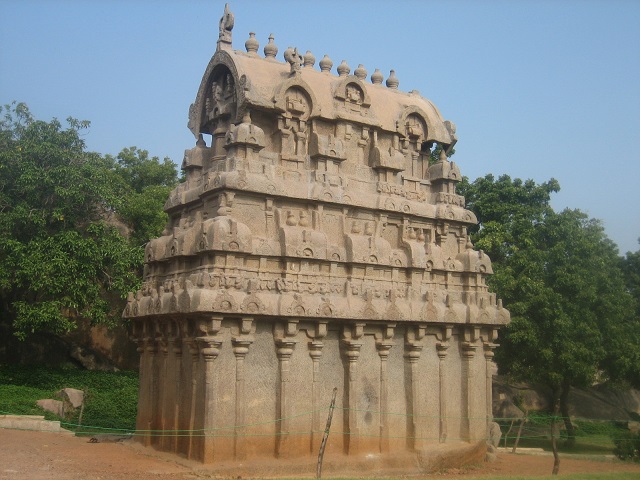Mamallapuram – The Workshop of the Pallavas
Ganesha Ratha

This ratha is hewn out of a singular granite boulder and is the most complete ratha in the town. The ratha was known as Arjuna Ratha when Lakshmiah Kavali visited the town in 1803. The name, Arjuna Ratha, might be due to its location as its stands near the Arjuna’s Penance relief. Kavali tells that once a shivalinga was installed inside the sanctum however it was removed by a British officer. This led the locals to install a Ganesha image inside and since then it is known is Ganesha Ratha. Kavali also mentions a stone Nandi, originally installed in front of the ratha, was taken away by Lord Clive, then governor of Madras.

In its style and design, this ratha very much resembles to the Bhima Ratha of the Pancha Ratha group. It faces west and measures 20 feet in length, 11.5 feet in width and 28 feet in height1. A projecting mukha-mandapa is supported on two pillars and two pilasters, all with lion-bases. At the terminals of this mandapa are two dvarapalas. Longhurst mentions that he was successful in discovering the original linga once installed inside this ratha, however the locals did not agree to remove the Ganesha image, therefore he placed that linga under a tree.


The ratha is dvi-tala (two story) structure built over a rectangular plan. Its main entrance is through a mukha-mandapa which is built over a roughly carved adhisthana (base) reachable by a flight of two rock-cut steps. The entrance has two pillars and two pilasters, all with lion bases. Above their bulbous capital is supported corbels with curved profile. At the terminals are provided niches framed within pilasters. These niches carry dvarapala images. The dvarapala on the viewer’s left is shown with heavy jata-bhara (headdress) with his one hand over a gada (club). The other dvarapala is also shown in similar manner as the former except that his hand does not rest over his gada. Above the pillars are supported a kapota (cornice) carrying regular gavaksha (kudu arches) with a human head inside, ten in total. Under this kapota is found the regular frieze of ganas or bhutas. The other sides are left plain, the longer side has eight pilasters and two corner pillars and the smaller side has four pilasters and two corner pillars. These pilasters have rectangular shaft at base and it turns into octagonal shaft above. Above the kapota is a row of vyalas with makara heads at the corners. Above this is the regular decoration of interconnected shrines, three sala (oblong) and two kutas (square), the latter is placed over the corners. The second story has pilasters supported walls all around, reduced in size in comparison to the first story. This story also has a kapota decorated with eight gavaksha (kudu arches). To contrast the two stories, the projections of the lower story were made recesses of the upper story and vice-versa. The shrine decoration of the second story is different from the lower story, as it has panjara model included with the regular sala and kuta. The panjara is extended to the vaulted roof shikhara as its nasis and maha-nasi.
The vaulted style shikhara has survived in full. gable end on the east side has survived with its full detail. The ridge of the roof is adorned with multiple stupis, nine in number. A trishula (trident) emblem is present at the terminals of the ridge. This motif is very significant as it has a face at the base supporting the three prongs of the trishula. This motif is also present above the nasikas (kudu arches) on the sides of the shikhara. It has a cylindrical shrine in the middle. Longhurst took this cylindrical object as a representation of a linga however Sankar Narayan, quoting Kamikagama, has appropriately explained this cylindrical decoration a vrtta-sphutitam used in decoration of temple vimana.
Inscriptions – There is a foundation inscription, present on the lateral wall of the mukha-mandapa. The inscription is the same as the one found in the Dharmaraja Mandapa. It gives the name of the temple as Atyantakama-pallaveshvara-griham. This inscription has been discussed in details in the chapter describing Dharmaraja Mandapa.
1 Longhurst, A H (1928). Pallava Architecture Part II. Archaeological Survey of India. New Delhi. pp 28-29

